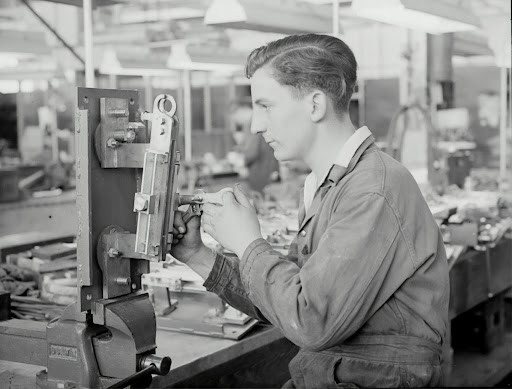Automation-Driven Injuries Are Rewriting Missouri's Workers'-Comp Playbook
Robots Arrive Faster Than Injuries Retrea

Manufacturers across the United States installed 44,303 new industrial robots in 2023, a 12 percent jump year-on-year, according to the International Federation of Robotics. Missouri is part of that surge: the state's factories employed 292,200 people in May 2024, up 1.5 percent from the previous year, even as production lines added cobots and six-axis arms, notes the Missouri Manufacturing Indicators brief. Automation might suggest safer workplaces, and national figures do show overall improvement. The latest Bureau of Labor Statistics news release reports that non-fatal injuries in U.S. manufacturing fell to 355,800 cases in 2023, with a recordable-case rate of 2.8 per 100 full-time workers, down from 396,800 cases the year before.
But dig deeper and a more uneven picture emerges. The Occupational Safety and Health Administration's robotics portal warns that most robot accidents occur during non-routine tasks such as programming, maintenance, or setup - exactly when human technicians enter a machine's safety envelope.
Warehouse automation offers a cautionary tale. An investigation highlighted by WIRED found that serious injuries were roughly twice as likely at Amazon facilities using robots compared with sites relying solely on human pickers.The lesson for Missouri's plants: adding robots without redesigning workflows may swap one set of hazards for another.
Liability Shifts Inside the Show-Me State
Missouri's workers'-comp apparatus is already absorbing the shock. Claims against the state's Second Injury Fund climbed from 2,787 in 2021 to 3,034 in 2024, according to the Division of Workers' Compensation Annual Report.Attorneys say a growing share stems from automation mishaps - crush injuries during lock-out lapses, ergonomic damage from accelerated line speeds, and tool-changer malfunctions that strike maintenance crews.
"Robots don't fatigue, but the people servicing them do," explains Phil Lawson, a Springfield-based safety consultant. "Compress cycle times by 20 percent and the human margin for error all but disappears."
If a grievously hurt technician sues a subcontractor or OEM, they will likely call a Kansas City Personal Injury Lawyer, raising the stakes for manufacturers that assumed workers'-comp alone would shield them from civil exposure.
What It Means for Carriers - and Premiums
For insurers, the actuarial math is shifting. Non-routine maintenance accidents tend to generate payouts far larger than classic slip-and-strain cases because they often involve amputation or de-gloving injuries with lifelong wage-loss components. One regional underwriter says premiums for fully automated lines "are starting to track closer to meat-packing than to traditional assembly."
Nationally, the National Council on Compensation Insurance has begun adding machine-specific risk modifiers - robot density, cycle velocity, maintenance intervals - to its Atlas data set, hinting at a future where underwriting looks as much at a plant's firmware logs as at its payroll tables. Emily Warren, a broker with Gallagher in St. Louis, notes that "clients running force-limited cobots gain credits, but those with legacy industrial arms inside tight cages are being debited."
Engineering Safer Cobots - and Safer Contracts
Technology offers partial remedies. New collaborative robots ship with torque-limited joints and computer vision that pauses motion when a human limb intrudes. Yet Saeed Gupta, R&D director for a Springfield auto-parts supplier, says culture matters more than sensors. "Our near-miss reports dropped 40 percent after we rewrote the maintenance SOP to force a dual-key lock-out and retrained every tech," he recalls.
Legal paperwork is evolving in tandem. Original-equipment manufacturers now demand indemnity clauses that flow down to systems integrators, while carriers want third-party safety audits before binding policies. Plant counsel Angela Ritter urges manufacturers to align warranties with ANSI/RIA R15.06 standards and to store digital proof of every software patch: "If an injury occurs during a firmware rollback and you can't show chain of custody, plaintiffs will label it negligence."
The Road Ahead
Automation is not slowing. The IFR's 2024 World Robotics report shows the global average robot density reached 162 units per 10,000 employees in 2023, more than double the level seven years earlier. IFR International Federation of Robotics As Missouri's factories race toward higher throughput, stakeholders must decide whether to treat safety as an afterthought or as core infrastructure.
The state's modest employment gains prove that humans remain central to production even in highly automated plants. Yet injury severity is rising in the edge cases - the midnight maintenance cycle, the hurried software patch - where human and machine overlap. Without a holistic approach that blends engineering controls, rigorous training, airtight documentation and forward-looking insurance, Missouri manufacturers may discover that the ultimate test of their automation strategy occurs not on the factory floor but in the courtroom.
© Copyright IBTimes 2025. All rights reserved.





















